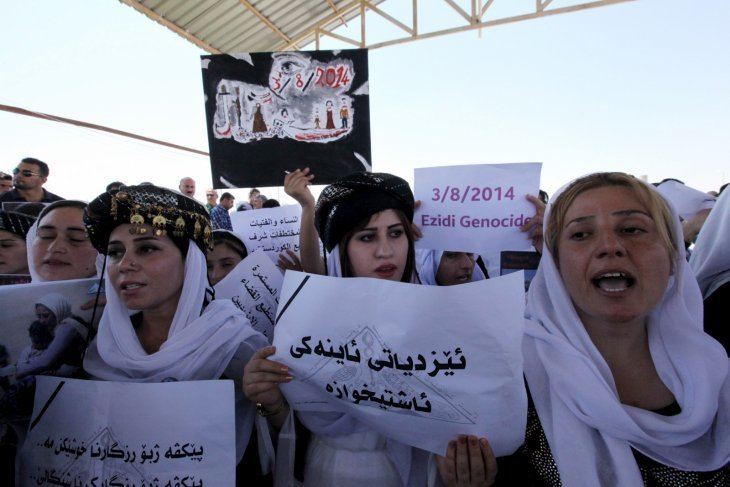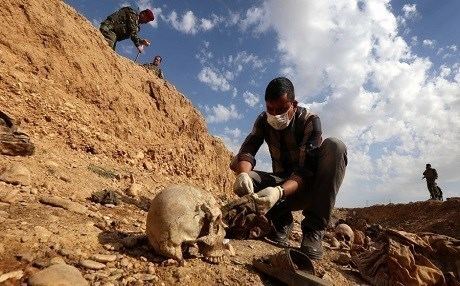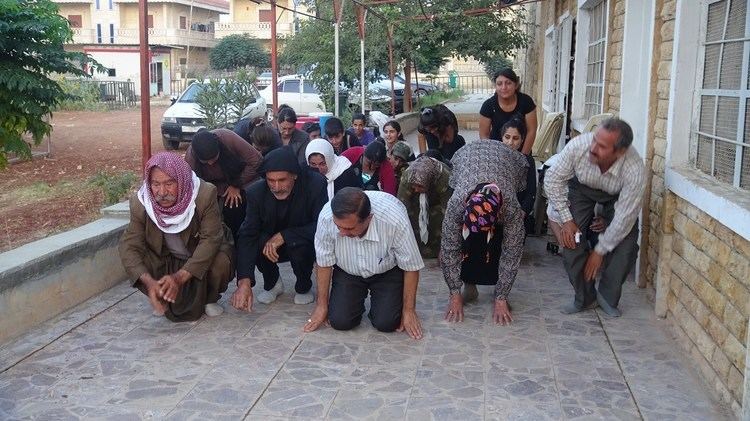Dates 3 Aug 2014 – 14 Aug 2014 | ||
Combatants Similar Battle of Ramadi (2014–15), Derna campaign, December 2014 Sinjar offensive, Salahuddin campaign, Battle of Baiji (2015) | ||
The Sinjar massacre was the killing of 5,000 Yazidi men in Sinjar (Kurdish: شنگال Şingal) city and Sinjar District in Iraq's Nineveh Governorate by the Islamic State of Iraq and the Levant (ISIL) in August 2014. This event started with ISIL attacking and capturing Sinjar and neighboring towns on 3 August, during ISIL's offensive in early August 2014.
Contents
- Background
- ISIL takeover and siege
- Killings throughout the Sinjar area
- Khocho massacre
- Counts of casualties
- IraqiUSUKAustralian food drops
- US air strikes
- Clearing a path for Yazidis
- Mountain siege ends US rescue mission canceled
- Western military response
- International bodies
- NGOs
- Turkish aid
- Aftermath new siege
- References

Dr Noori Abdulrahman, head of the Department of Coordination and Follow-up of the Iraqi Kurdistan Regional Government, stated that ISIL's 3 August campaign against Sinjar was more about demography and strategy than about religion. According to Abdulrahman, ISIL wanted to push most of the Kurds out of this strategic Yazidi areas and bring in Arabs, obedient to ISIL.
On 8 August 2014, the United States reacted with airstrikes on ISIL units and convoys in northern Iraq, which led to a war of several countries against ISIL. The assistance of PKK and YPG enabled the majority of the 50,000 Yazidis who fled into the Sinjar Mountains to be evacuated.

On 17 December 2014, the Kurdish Peshmerga, PKK and YPG forces started the December 2014 Sinjar offensive with the support of US airstrikes.
Background
Sinjar was predominantly inhabited by Yazidis before the ISIL takeover.

On 29 June 2014, Islamic State of Iraq and the Levant (ISIL) declared itself a caliphate in areas of Syria and Iraq, and that month they took control of significant territories in northern Iraq. While Iraqi federal military forces fled from the advancing ISIL troops, Iraqi Kurdish Peshmerga fighters took control of a wide territory in northern Iraq.
ISIL takeover and siege

On the morning of 3 August 2014, ISIL forces captured the city of Sinjar as well as the Sinjar area. As ISIL attacked Sinjar and neighboring cities, 11.000 Iraqi Kurdish peshmerga forces in Sinjar withdrew in the night from those cities, leaving the civilians behind without warning. ISIL then destroyed a Shiite Zainab shrine in Sinjar, executed resisters, and demanded the residents to swear allegiance or be killed.
In surrounding villages, many residents fled immediately. According to Yazidis, ISIL fighters asked the remaining Yazidis to convert to Islam or face death, and ISIL Twitter accounts posted images of murders on individuals in the Sinjar area.
Almost 200,000 civilians, mostly Yazidis along with Shia, managed to flee from the fighting in Sinjar city. About 50,000 of those Yazidis fled into the Sinjar Mountains, where they were trapped without food, water or medical care, facing starvation and dehydration.
The U.S. government, Kurdish Peshmerga forces, and Western media reported that thousands of Yazidis in the Sinjar Mountains were under siege by ISIL.
Tahseen Said, the emir of the Yazidis, on 3 August 2014 issued an appeal to world leaders, asking for humanitarian help in the plight and difficult conditions of his people being attacked by ISIL. On 4 August, Kurdish fighters reportedly battled ISIL to retake Sinjar.
Killings throughout the Sinjar area
The New York Times reported on 7 August 2014 that ISIL had executed dozens of Yazidi men in Sinjar city and had taken their wives for unmarried jihadi fighters. It was also reported that ISIL fighters executed over ten caretakers of Shia Sayeda Zeinab shrine in Sinjar before blowing it up.
While the siege of Mount Sinjar was continuing, ISIL killed hundreds of Yazidis in at least six of the nearby villages. 250–300 men were killed in the village of Hardan, 200 between Adnaniya and Jazeera, 70–90 in Qiniyeh, and on the road out of al-Shimal witnesses reported seeing dozens of bodies. Hundreds of others had also been killed for refusing to convert to Islam.
Khocho massacre
On 15 August 2014, in the Yazidi village of Khocho, south of Sinjar, after the whole population had received the jihadist ultimatum to convert or be killed, over 80 men were killed. A witness recounted that the villagers were first converted under duress, but when the village elder refused to convert, all of the men were taken in trucks under the pretext of being led to Sinjar, and gunned down along the way. According to reports from survivors interviewed by OHCHR, on 15 August, the entire male population of the Yazidi village of Khocho, up to 400 men, were rounded up and shot by ISIL, and up to 1,000 women and children were abducted.
On the same day, up to 200 Yazidi men were reportedly executed for refusing conversion in a Tal Afar prison. The massacres took place at least until 25 August when ISIL executed 14 elderly Yazidi men in Sheikh Mand Shrine in Jidala, western Sinjar, and blew up the shrine there.
Counts of casualties
A civilian reported that on 3 August 2014 alone, 2000 Yazidis had been killed throughout the Sinjar District. A Yazidi member of the Council of Representatives of Iraq said that between 2 and 5 August, 500 Yazidi men had been slaughtered in the city of Sinjar by ISIL, women had been killed or sold into slavery, and 70 children had died from thirst or suffocation while fleeing the ISIL advance.
From the findings of a joint October 2014 report of OHCHR and UNAMI, ISIL had massacred up to 5000 Yazidi men during August 2014. The Iraqi Kurdistan Regional Government estimated in December 2014 that the total number of killed or missing Yazidi men, women and children from Sinjar since August amounted to around 4000.
Iraqi/US/UK/Australian food drops
40,000 or more Yazidis were trapped in the Sinjar Mountains and mostly surrounded by ISIL forces who were firing on them. They were largely without food, water or medical care, facing starvation and dehydration.
On 5 August 2014, Iraqi military helicopters reportedly dropped some food and water for the Yazidis in the mountains. On 7 August, the U.S. also started dropping food and water.
Starting on 10 August, also U.K. planes dropped food and water for the Yazidis in the mountains and France also promised aid to the refugees.
On 12 August, an Iraqi military helicopter, piloted by Maj. Gen. Majid Abdul Salam Ashour, crashed in the mountains while delivering aid and rescuing stranded Yazidi refugees. The general was killed in the crash, while most of the passengers were injured.
On 13 August, a 16-aircraft mission including US C-17s and C-130Hs, an Australian C-130J, and a British C-130J delivered supplies to mostly Yezidi civilians stranded on Mount Sinjar.
U.S. air strikes
On 7 August 2014, the U.S. President, Barack Obama, stated that the U.S. was starting air strikes to prevent a potential massacre (genocide) by ISIL of thousands of Yazidis trapped in the Sinjar Mountains. Obama further defended his decision by saying:
The world is confronted by many challenges. And while America has never been able to right every wrong, America has made the world a more secure and prosperous place. And our leadership is necessary to underwrite the global security and prosperity that our children and our grandchildren will depend upon. We do so by adhering to a set of core principles.
We do whatever is necessary to protect our people. We support our allies when they're in danger. We lead coalitions of countries to uphold international norms. And we strive to stay true to the fundamental values – the desire to live with basic freedom and dignity – that is common to human beings wherever they are. That's why people all over the world look to the United States of America to lead. And that's why we do it.
On 8 August 2014, US airstrikes were launched in the Erbil area, 180 km east of Sinjar. The first airstrikes in the Mount Sinjar area were reported on 9 August, when the US launched four strikes against armored fighting vehicles of ISIL fighters threatening civilians on Mount Sinjar. The continued Iraqi airdrops of food and water in the Sinjar Mountains and their picking up of some Yazidis were also backed up by the U.S. airstrikes.
After their air strikes, the U.S. government pondered until 13 August on the possibilities and necessity of a rescue operation with U.S. ground troops or U.S. airlifts.
Clearing a path for Yazidis
Between 9 and 11 August 2014, a safe corridor was established from the mountain enabling 10,000 people to evacuate on the first day. Kurdish fighters of Kurdistan Workers' Party entered the Sinjar Mountains with trucks and tractors to carry out the sick and elderly into Syria via a path that was cleared by Syrian Kurdish militants (YPG). According to Dr. Salim Hassan, a professor at the University of Sulaymaniyah and spokesman of the uprooted Yazidis, the PKK and YPG enabled an estimated 35,000 of the initially 50,000 trapped Yazidis to escape into Syria. According to the account of the Sinjar District Governor, the route was jointly set up by Iraqi Kurdish security forces (Peshmerga) and the YPG.
Mountain siege ends, U.S. rescue mission canceled
On 12 or 13 August 2014, a dozen U.S. Marines and special forces servicemen landed on Mount Sinjar from V-22 aircraft to assess options for a potential rescue of Yazidi refugees joining British SAS already in the area. They reported that "the situation is much more manageable", that there were now far fewer Yazidis on the mountain than expected, and that those Yazidis were in relatively good condition. A U.S. rescue mission for those still on the mountain was therefore "far less likely now", said Defense Secretary Chuck Hagel.
The U.S. government officially declared the siege to be broken on 13 August 2014. This was reportedly done by U.S airstrikes and Kurdish fighters of the People's Protection Units from Syria, together with their PKK allies from Turkey, allowing more than 50,000 refugees to escape. Despite this, according to professor Salim Hassan, between 5,000 and 10,000 people still remained trapped in the mountains. They were reportedly afraid to return to their homes and were sustained in the coming months by airdrops from a lone Iraqi helicopter.
Western military response
On 7 August 2014, U.S. President Obama ordered targeted airstrikes on IS militants and emergency air relief for the Yazidis. Airstrikes began on 8 August. (See American-led intervention in Iraq (2014–present) § Obama authorizes airstrikes.)
On 8 August 2014, the US asserted that the systematic destruction of the Yazidi people by the Islamic State was genocide.
President Barack Obama had authorized the attacks to protect Yazidis but also Americans and Iraqi minorities. President Obama gave an assurance that no troops would be deployed for combat. Along with the airstrikes of 9 August, the US airdropped 3,800 gallons of water and 16,128 MREs. Following these actions, the United Kingdom and France stated that they also would begin airdrops.
On 10 August 2014, at approximately 2:15 a.m. ET, the US carried out five additional airstrikes on armed vehicles and a mortar position, enabling 20,000–30,000 Yazidi Iraqis to flee into Syria and later be rescued by Kurdish forces. The Kurdish forces then provided shelter for the Yazidis in Dohuk.
On 13 August 2014, fewer than 20 United States Special Forces troops stationed in Irbil along with British Special Air Service troops visited the area near Mount Sinjar to gather intelligence and plan the evacuation of approximately 30,000 Yazidis still trapped on Mount Sinjar. One hundred and twenty-nine additional US military personnel were deployed to Irbil to assess and provide a report to President Obama. The United States Central Command also reported that a seventh airdrop was conducted and that to date, 114,000 meals and more than 35,000 gallons of water had been airdropped to the displaced Yazidis in the area.
In a statement on 14 August 2014, The Pentagon said that the 20 US personnel who had visited the previous day had concluded that a rescue operation was probably unnecessary since there was less danger from exposure or dehydration and the Yazidis were no longer believed to be at risk of attack from ISIL. Estimates also stated that 4,000 to 5,000 people remained on the mountain, with nearly half of them being Yazidi herders who lived there before the siege.
Kurdish officials and Yazidi refugees stated that thousands of young, elderly, and disabled individuals on the mountain were still vulnerable, with the governor of Kurdistan's Dahuk province, Farhad Atruchi, saying that the assessment was "not correct" and that although people were suffering, "the international community is not moving".
International bodies
NGOs
Turkish aid
Hundreds and possibly thousands of Yazidis have taken refuge in neighboring Turkey, where they are being sheltered in refugee camps in the city of Silopi. The Turkish Disaster Relief Agency (AFAD) has begun preparations to set up camps for receiving 6,000 refugees from Iraq. The number of Yazidi refugees in Turkey has reached 14 thousand by August 30.
Turkey has also airdropped humanitarian aid to Yazidi refugees within Iraq. However, neither Iraq nor the Iraqi Kurdistan confirmed Turkey's humanitarian aids.
Aftermath – new siege
After August 2014, ISIL held onto the town of Sinjar. Several thousand or around 10,000 Yazidis remained in the Sinjar Mountains located to the city’s north, sustained by airdrops from a lone Iraqi helicopter, while an escape road from the mountains northward to Kurdish areas was under Kurdish/Yazidi control. American officials said that some of those Yazidis considered the Sinjar Mountains a place of refuge and home and did not want to leave; while a report from The New Yorker said some were afraid to return to their homes. Other Yazidis also came to the mountains after the August evacuations.
On 21 October, ISIL seized terrain north of the mountains, thus cutting the area's escape route to Kurdish areas. The Yazidi militias then withdrew from there into the Sinjar Mountains, where the number of Yazidi civilian refugees was estimated at 2,000–7,000. The mountains had once again been partially besieged by ISIL.
On 17 December, Peshmerga forces, backed by 50 U.S.-led coalition airstrikes on ISIL positions, launched an offensive to liberate Sinjar and to break that partial ISIL siege of the Sinjar Mountains. In less than two days, the Peshmerga seized the mountain range. After ISIL forces retreated, Kurdish fighters were initially faced with clearing out mines around the area, but quickly opened a land corridor to those mountains, enabling Yazidis to be evacuated. The operation left 100 ISIL fighters dead.
Late on 21 December, Syrian Kurdish YPG fighters south of the mountain range reached Peshmerga lines, thus linking their two fronts. The next day, the YPG broke through ISIL lines, thus opening a corridor from Syria to the town of Sinjar. By the evening, the Peshmerga took control of much of Sinjar.
